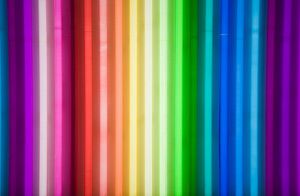A page from the "Causes of Color" exhibit...
Why are fire and flames colored? (incandescence)

From ancient times, when fire helped ensure human survival, to today’s romantic candlelit dinner, the magic and mystery of flames have entranced and enchanted us.
The concept of color temperature has permeated our everyday language. For example, we use the term "red hot" to qualify everything from a fashion trend, to a spicy food, to a temperature hot enough to melt iron. However, terms related to color temperature can lead to confusion, especially when talking about flames themselves. Incandescence does color a flame, but it is not the only source of its color.

A rainbow of neon tubes displays the variety of colors available through gas excitation.
Gas excitations
Gas excitations are responsible for vivid examples of colored light. Arc lighting, sparks, neon lights, sodium or mercury vapor lamps, and the aurora rely on gas excitations for their striking colors. Lightning and fireworks, while obtaining their bright white colors from incandescence, also display a range of other colors obtained through gas excitations. Scientists use the same phenomenon to identify different elements in flame tests.




